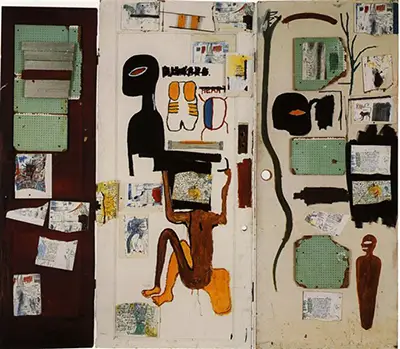We can immediately see bits of paper which has been re-used for this artwork and Basquiat was someone who used collage techniques in a number of his artworks. He chooses not to use much text in this piece, but instead makes use of a number of figurative portraits, all of which have his very particular method of producing eyes. He would generally paint eyes without pupils which gave them a sinister look and this approach shows an influence from traditional African art, including sculptures and masks. He was proud of his roots and would often try to help to support other members of this community. He even went as far as producing political messages in some of his paintings which normally drew attention to the inequalities found in some areas of society which he was clearly concerned about.
The overall piece is approximately two metres tall and wide, which was a fairly standard size for the artist during this part of his career as he loved to produce huge artworks that held almost a mural quality to them. He felt that size could shock and excite the viewer, particularly when combined with his own bright and expressive content. Many other famous names would do the same in the second half of the 20th century, such as Mark Rothko, Jackson Pollock to name just two. Basquiat was entirely original though in a number of different ways, both in the influences on his style but also in how he combined different media together. There was also his set of symbols that were repeated throughout his career, such as his crowns and also the use of skulls and cars.
Many saw the qualities of this artist during his career and purchased some of his work, before later selling it on for huge profits as Basquiat's reputation rose considerably. Some see modern art as an investment opportunity and those who choose well can make considerable amounts of money, whilst others simply collect artworks which they like and just happen to have good taste. Many of those who purchase paintings such as these will later donate them to local galleries and museums so that the public can see them in person, if their own interests lie more in the art than any potential financial gain.


